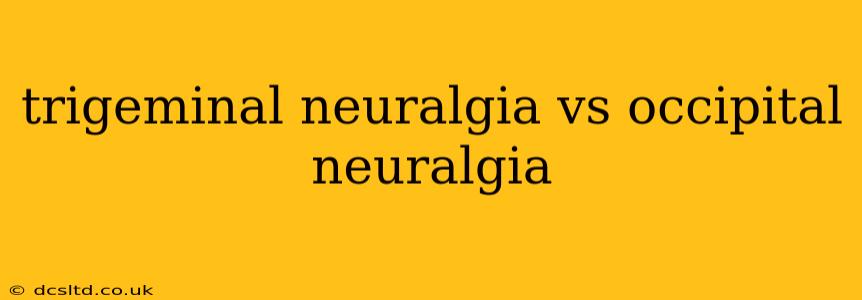Trigeminal neuralgia and occipital neuralgia are both types of neuropathic pain, meaning they stem from damaged or malfunctioning nerves. While both conditions cause intense, often debilitating pain, they differ significantly in their location, underlying causes, and treatment approaches. Understanding these differences is crucial for accurate diagnosis and effective management.
What is Trigeminal Neuralgia?
Trigeminal neuralgia (TN), also known as tic douloureux, affects the trigeminal nerve, the fifth cranial nerve. This nerve carries sensation from your face, including your forehead, cheek, jaw, and even parts of your eye. The pain associated with TN is typically described as a sharp, stabbing, electric shock-like sensation that can last from a few seconds to several minutes. These episodes can occur frequently, sometimes triggered by seemingly innocuous stimuli like brushing teeth, eating, or even a light breeze.
What causes Trigeminal Neuralgia?
The exact cause of trigeminal neuralgia remains elusive, but it's often linked to compression or irritation of the trigeminal nerve, frequently by a blood vessel. Other possible causes include multiple sclerosis, tumors, or nerve damage due to surgery or trauma.
What is Occipital Neuralgia?
Occipital neuralgia involves the greater and lesser occipital nerves, which supply sensation to the back of the head, scalp, and neck. Pain from occipital neuralgia is usually described as a burning, aching, or stabbing sensation, often radiating from the base of the skull up to the top of the head and potentially down the neck. Unlike the short, intense bursts of trigeminal neuralgia, occipital neuralgia pain can be more persistent and less episodic.
What causes Occipital Neuralgia?
Several factors can contribute to occipital neuralgia. These include:
- Muscle strain or spasms: Tight muscles in the neck and shoulders can compress the occipital nerves.
- Cervical spondylosis: Degenerative changes in the cervical spine can irritate the nerves.
- Trauma: Injuries to the head or neck can damage the occipital nerves.
- Infections: Certain infections can cause inflammation and irritation of the nerves.
Trigeminal Neuralgia vs. Occipital Neuralgia: A Comparison Table
| Feature | Trigeminal Neuralgia | Occipital Neuralgia |
|---|---|---|
| Affected Nerve | Trigeminal nerve (5th cranial nerve) | Greater and lesser occipital nerves |
| Location of Pain | Face, including forehead, cheek, jaw, and eye area | Back of the head, scalp, and potentially down the neck |
| Pain Description | Sharp, stabbing, electric shock-like, brief episodes | Burning, aching, stabbing, more persistent pain |
| Triggers | Often triggered by touch, chewing, or temperature changes | Often associated with neck posture and muscle tension |
| Common Causes | Blood vessel compression, MS, tumors, trauma | Muscle strain, cervical spondylosis, trauma, infections |
How are Trigeminal Neuralgia and Occipital Neuralgia Diagnosed?
Diagnosis typically involves a thorough neurological examination, including a detailed description of the pain and its location, as well as a review of the patient's medical history. Imaging studies, such as MRI or CT scans, may be used to rule out other conditions and identify any underlying structural abnormalities.
What are the treatment options for Trigeminal Neuralgia and Occipital Neuralgia?
Treatment approaches for both conditions are similar and often involve a combination of strategies:
- Medications: Pain relievers, anti-seizure drugs (like carbamazepine), and antidepressants can help manage pain.
- Injections: Botox injections or steroid injections into the affected nerve may provide temporary relief.
- Surgery: In severe cases, surgery may be considered to decompress the nerve or destroy the nerve fibers responsible for the pain.
What is the prognosis for Trigeminal Neuralgia and Occipital Neuralgia?
The prognosis varies depending on the severity of the condition and the effectiveness of treatment. Many individuals experience significant pain relief with medication or other conservative treatments. However, some may require more aggressive interventions, and the condition may recur.
Can I prevent Trigeminal Neuralgia and Occipital Neuralgia?
While prevention isn't always possible, maintaining good neck posture, managing stress, and practicing regular gentle neck stretches may help reduce the risk of occipital neuralgia. For trigeminal neuralgia, preventative measures are less clear, but avoiding trauma to the face is advisable.
This information is for general knowledge and does not constitute medical advice. Always consult a healthcare professional for diagnosis and treatment of any medical condition.
